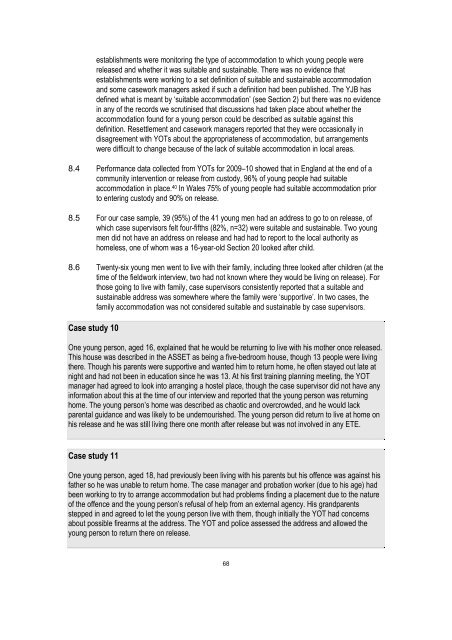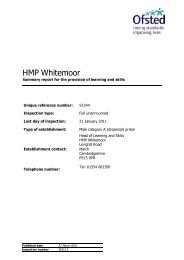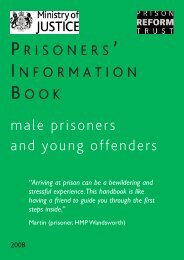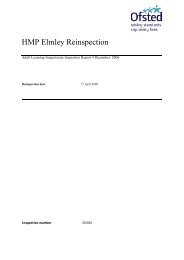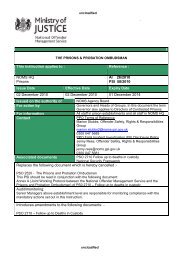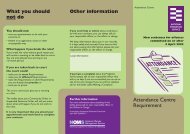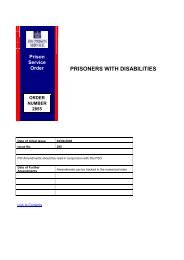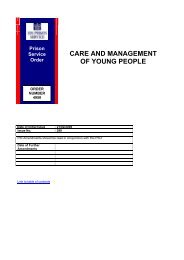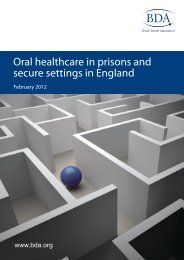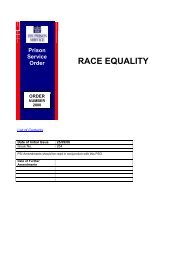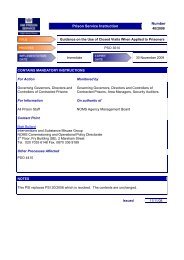Resettlement provision for children and young ... - Ministry of Justice
Resettlement provision for children and young ... - Ministry of Justice
Resettlement provision for children and young ... - Ministry of Justice
You also want an ePaper? Increase the reach of your titles
YUMPU automatically turns print PDFs into web optimized ePapers that Google loves.
establishments were monitoring the type <strong>of</strong> accommodation to which <strong>young</strong> people were<br />
released <strong>and</strong> whether it was suitable <strong>and</strong> sustainable. There was no evidence that<br />
establishments were working to a set definition <strong>of</strong> suitable <strong>and</strong> sustainable accommodation<br />
<strong>and</strong> some casework managers asked if such a definition had been published. The YJB has<br />
defined what is meant by ‘suitable accommodation’ (see Section 2) but there was no evidence<br />
in any <strong>of</strong> the records we scrutinised that discussions had taken place about whether the<br />
accommodation found <strong>for</strong> a <strong>young</strong> person could be described as suitable against this<br />
definition. <strong>Resettlement</strong> <strong>and</strong> casework managers reported that they were occasionally in<br />
disagreement with YOTs about the appropriateness <strong>of</strong> accommodation, but arrangements<br />
were difficult to change because <strong>of</strong> the lack <strong>of</strong> suitable accommodation in local areas.<br />
8.4 Per<strong>for</strong>mance data collected from YOTs <strong>for</strong> 2009–10 showed that in Engl<strong>and</strong> at the end <strong>of</strong> a<br />
community intervention or release from custody, 96% <strong>of</strong> <strong>young</strong> people had suitable<br />
accommodation in place. 40 In Wales 75% <strong>of</strong> <strong>young</strong> people had suitable accommodation prior<br />
to entering custody <strong>and</strong> 90% on release.<br />
8.5 For our case sample, 39 (95%) <strong>of</strong> the 41 <strong>young</strong> men had an address to go to on release, <strong>of</strong><br />
which case supervisors felt four-fifths (82%, n=32) were suitable <strong>and</strong> sustainable. Two <strong>young</strong><br />
men did not have an address on release <strong>and</strong> had had to report to the local authority as<br />
homeless, one <strong>of</strong> whom was a 16-year-old Section 20 looked after child.<br />
8.6 Twenty-six <strong>young</strong> men went to live with their family, including three looked after <strong>children</strong> (at the<br />
time <strong>of</strong> the fieldwork interview, two had not known where they would be living on release). For<br />
those going to live with family, case supervisors consistently reported that a suitable <strong>and</strong><br />
sustainable address was somewhere where the family were ‘supportive’. In two cases, the<br />
family accommodation was not considered suitable <strong>and</strong> sustainable by case supervisors.<br />
Case study 10<br />
One <strong>young</strong> person, aged 16, explained that he would be returning to live with his mother once released.<br />
This house was described in the ASSET as being a five-bedroom house, though 13 people were living<br />
there. Though his parents were supportive <strong>and</strong> wanted him to return home, he <strong>of</strong>ten stayed out late at<br />
night <strong>and</strong> had not been in education since he was 13. At his first training planning meeting, the YOT<br />
manager had agreed to look into arranging a hostel place, though the case supervisor did not have any<br />
in<strong>for</strong>mation about this at the time <strong>of</strong> our interview <strong>and</strong> reported that the <strong>young</strong> person was returning<br />
home. The <strong>young</strong> person’s home was described as chaotic <strong>and</strong> overcrowded, <strong>and</strong> he would lack<br />
parental guidance <strong>and</strong> was likely to be undernourished. The <strong>young</strong> person did return to live at home on<br />
his release <strong>and</strong> he was still living there one month after release but was not involved in any ETE.<br />
Case study 11<br />
One <strong>young</strong> person, aged 18, had previously been living with his parents but his <strong>of</strong>fence was against his<br />
father so he was unable to return home. The case manager <strong>and</strong> probation worker (due to his age) had<br />
been working to try to arrange accommodation but had problems finding a placement due to the nature<br />
<strong>of</strong> the <strong>of</strong>fence <strong>and</strong> the <strong>young</strong> person’s refusal <strong>of</strong> help from an external agency. His gr<strong>and</strong>parents<br />
stepped in <strong>and</strong> agreed to let the <strong>young</strong> person live with them, though initially the YOT had concerns<br />
about possible firearms at the address. The YOT <strong>and</strong> police assessed the address <strong>and</strong> allowed the<br />
<strong>young</strong> person to return there on release.<br />
68


